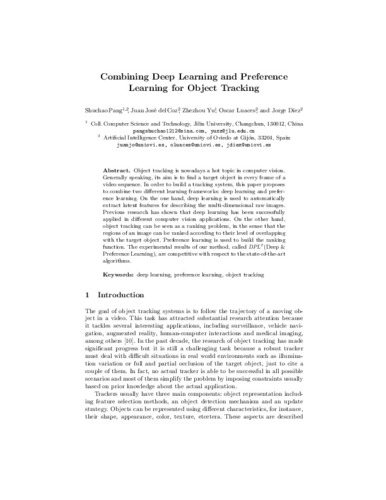Combining Deep Learning and Preference Learning for Object Tracking
Autor(es) y otros:
Palabra(s) clave:
Deep learning
Preference learning
Object tracking
Fecha de publicación:
Editorial:
Springer
Versión del editor:
Citación:
Serie:
Lecture Notes in Computer Science;9949
Descripción física:
Resumen:
Object tracking is nowadays a hot topic in computer vision. Generally speaking, its aim is to find a target object in every frame of a video sequence. In order to build a tracking system, this paper proposes to combine two different learning frameworks: deep learning and preference learning. On the one hand, deep learning is used to automatically extract latent features for describing the multi-dimensional raw images. Previous research has shown that deep learning has been successfully applied in different computer vision applications. On the other hand, object tracking can be seen as a ranking problem, in the sense that the regions of an image can be ranked according to their level of overlapping with the target object. Preference learning is used to build the ranking function. The experimental results of our method, called DPL2DPL2(Deep & Preference Learning), are competitive with respect to the state-of-the-art algorithms
Object tracking is nowadays a hot topic in computer vision. Generally speaking, its aim is to find a target object in every frame of a video sequence. In order to build a tracking system, this paper proposes to combine two different learning frameworks: deep learning and preference learning. On the one hand, deep learning is used to automatically extract latent features for describing the multi-dimensional raw images. Previous research has shown that deep learning has been successfully applied in different computer vision applications. On the other hand, object tracking can be seen as a ranking problem, in the sense that the regions of an image can be ranked according to their level of overlapping with the target object. Preference learning is used to build the ranking function. The experimental results of our method, called DPL2DPL2(Deep & Preference Learning), are competitive with respect to the state-of-the-art algorithms
Descripción:
International Conference on Neural Information Processing, ICONIP 2016 (23th. 2016. Kyoto, Japan)
ISBN:
Patrocinado por:
This work was funded by Ministerio de Economía y Competitividad de Españna (grant TIN2015-65069-C2-2-R), Specialized Research Fund for the Doctoral Program of Higher Education of China (grant 20120061110045) and the Project of Science and Technology Development Plan of Jilin Province, China (grant 20150204007GX)
Colecciones
- Capítulos de libros [6480]
- Informática [870]
- Investigaciones y Documentos OpenAIRE [8282]
Ficheros en el ítem




